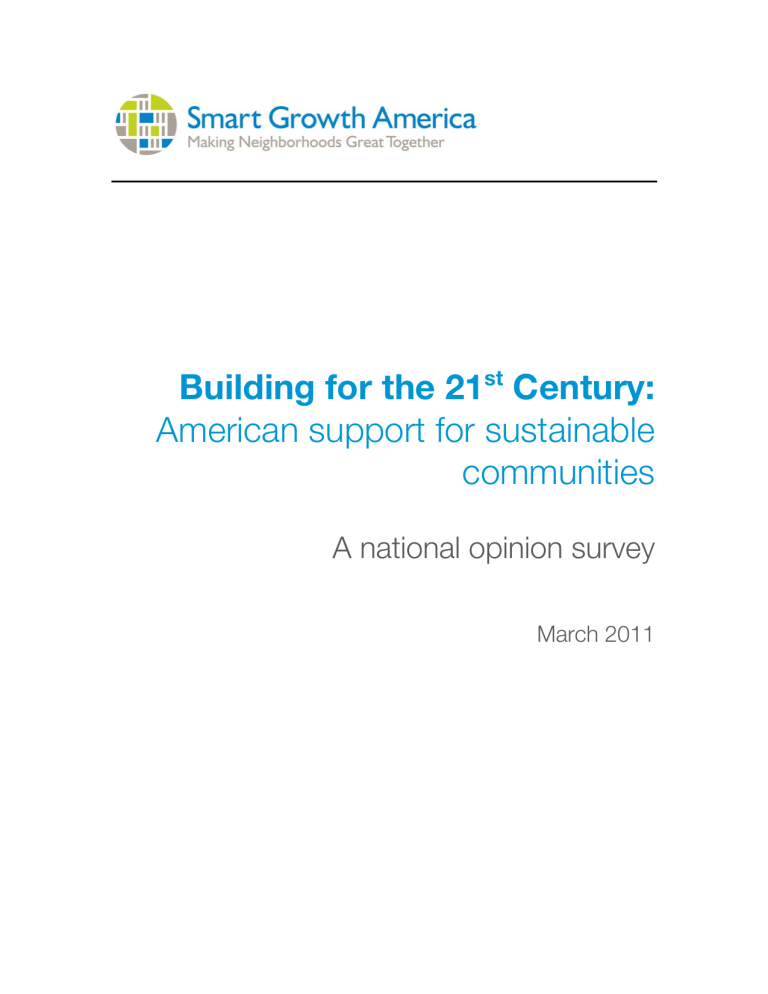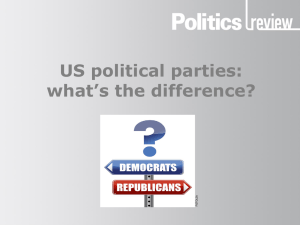Building for the 21 Century: American support for sustainable communities

Building for the 21
st
Century:
American support for sustainable communities
A national opinion survey
March 2011
Overview
A recent poll by Smart Growth America has found that in the midst of a struggling
U.S. economy, support for smart growth strategies remains high among Americans on both sides of the aisle.
The poll focused specifically on support for sustainable communities: urban, suburban or rural communities that have more housing and transportation choices, are closer to jobs, shops or schools, are more energy independent and help protect clean air and water. Making communities more sustainable means generating more jobs, lowering housing and transportation costs and using limited public funds more wisely.
As the U.S. economy incrementally recovers, Americans want the federal government to stop spending into deficit and use the money it does have more effectively. Smart growth strategies do just that by reducing infrastructure costs at the state and federal level, strengthening local and state revenues and building economic wealth by investing in existing communities.
Smart Growth America’s poll reveals that Americans understand the benefits of sustainable communities and want to see more of them. The poll of 1,200 people was conducted in late 2010 by Collective Strength and reviewed by Harris
Interactive. The results are calibrated to mirror current U.S. Census estimates for age, race, income, gender and region, with a +/- 3% margin of error. The poll was made possibly through funding from the Ford Foundation.
Major Findings
The majority of Americans – regardless of political affiliation – support sustainable communities.
The survey found that 79% of Americans overall support the idea of an “urban, suburban, or rural community that has more housing and transportation choices, is closer to jobs, shops or schools, is more energy independent, and helps protect clean air and water.” 76% of Independent voters, 72% of Republicans, 89% of
Democrats and 65% of those polled with no party affiliation support this idea. Only
5% of respondents said they opposed this idea.
The majority of Americans believe their region needs more sustainable communities.
Americans living in all types of areas – in rural, suburban and urban areas alike – want more sustainable communities. When asked whether their region of the
country needs more sustainable communities, 66% of respondents replied yes.
Only 15% said no, 19% were not sure. 74% of Americans in urban areas, 67% of
Americans in suburban areas and 54% of Americans in rural areas agreed that their region needs more sustainable communities. 61% of Independent voters agreed, along with 58% of Republicans, 79% of Democrats and 54% of those polled with no party affiliation.
Most Americans believe that sustainable communities are an important part of rebuilding the national economy.
More than 80% of voters nationwide agree that sustainable communities are an important part of rebuilding the national economy, ranking the issue 5 or above on a 10-point scale. In addition, 43% of Independent voters, along with 43% of
Republicans, 66% of Democrats and 50% of those polled with no party affiliation believe that sustainable communities are extremely important – ranking the issue a
9 or 10 on a 10-point scale – for rebuilding the American economy. Research shows that smart growth solutions create more jobs in our local communities, help people and our municipalities save money, and attract businesses to our neighborhoods.
The findings also reveal that spending on transportation infrastructure – like road repair, trains or buses – ranks higher than both investing in technology/innovation and investments in clean energy and green jobs as ways to rebuild the economy.
The majority of Americans agree about problems that can be solved by smart growth solutions.
Across all regions and all political parties, Americans agree that our country faces several problems that can be solved, in part, by smart growth solutions:
•
84% of Americans believe that our country is too dependent on oil.
77% of Independent voters, 77% of Republicans, 95% of Democrats and
82% of those polled with no party affiliation agree with this statement. Smart growth strategies provide alternatives to driving that give families lower cost transportation choices, reduce how much they need to drive and decrease our dependence on oil.
•
82% of Americans agree that spending 50% of a household budget on housing and transportation – which most Americans families do – is simply too much.
77% of Independent voters, 77% of Republicans, 87% of Democrats and 90% of those polled with no party affiliation agree that
50% of a household budget is too much to spend on transportation and housing. By providing low-cost transportation choices, reducing the distance between home and work and placing schools and shops close by smart growth strategies help reduce these combined costs.
•
82% of Americans believe that rebuilding our economy and creating new jobs is the most important issue of our generation.
76% of
Independent voters, 84% of Republicans, 84% of Democrats and 81% of those polled with no party affiliation agree that rebuilding our economy is more important than any other issue facing America today. Smart growth strategies help build the foundation for long-term economic growth by
• creating jobs today and reducing the fiscal burden on towns and states for the future.
75% of Americans agree that infrastructure spending on roads, trains, and buses creates jobs and helps the economy get stronger.
68% of Independent voters, 67% of Republicans, 89% of Democrats and
70% of those polled with no party affiliation agree that investing in transportation infrastructure creates jobs and helps the economy get stronger. This isn’t just belief, it’s a fact: Repairing roads and bridges creates
16% more jobs per dollar than building new ones, and building public transportation creates 31% more jobs per dollar than building roads.
•
67% of Americans agree that the federal government should use the money it has more effectively.
73% of Independent voters, 69% of
Republicans, 63% of Democrats and 63% of those polled with no party affiliation agree that the federal government should use the money it has more wisely. Smart growth strategies offer taxpayers a better return on investment at both the state and federal level: state governments that reinvest in existing communities save money by spending less on infrastructure, and the federal government supports greater private investment in our communities through better program coordination.
There is a clear demand for homes in sustainable communities and that demand is growing.
58% of Americans report that being able to walk to stores or restaurants will have a very strong impact on their next decision about where to live. This number is significantly higher than the 20% of Americans who report considering this factor in their last move. 63% of Americans agreed that lower transportation costs would be a significant reason to move to a sustainable community where they could walk to shops, and 58% agreed that “wasting less time driving around” was another key reason.
Americans overwhelmingly support the guiding principles of the federal Partnership for Sustainable
Communities.
The Partnership for Sustainable Communities, an unprecedented collaboration
between the U.S. Department of Transportation, the U.S. Department of Housing and Urban Development and the U.S. Environmental Protection Agency, uses the power of the federal government to help communities across the country rebuild their economy and create more sustainable communities.
Smart Growth America’s poll found overwhelming public support for the
Partnership’s core principles, including its aims to:
•
Improve economic competitiveness through reliable and timely access to employment centers, educational opportunities, services and other basic needs by workers as well as expanded business access to markets. 88% of all respondents support this goal, including 90% of Independent voters, 81% of Republican voters, 93% of Democrat voters and 83% of unaffiliated voters.
•
Develop safe, reliable and economical transportation choices to decrease household transportation costs, reduce our nation’s dependence on oil, improve air quality and promote public health. 83% of Americans support this goal, including 77% of Independent voters, 73% of
Republicans, 96% of Democrats and 86% of unaffiliated voters. In addition,
75% of rural area residents support this goal, along with 86% of suburban residents and 86% of urban residents.
•
Expand location- and energy-efficient housing choices for people of all ages, incomes, races and ethnicities to increase mobility and lower the combined cost of housing and transportation. 83% of Americans support this goal, including 76% of Independent voters, 70% of Republicans, 97% of
Democrats and 86% of unaffiliated voters. 72% of rural area residents support this goal, along with 84% if suburban residents and 88% or urban residents.
•
Enhance the unique characteristics of all communities by investing in healthy, safe and walkable neighborhoods. 87% of Americans support this goal, including 81% of Independent voters, 79% of Republicans, 96% of
Democrats and 91% of unaffiliated voters. In addition, 79% of rural area residents support this goal, along with 86% of suburban residents and 94% of urban residents.
•
Target federal funding toward existing communities through such strategies as reinvesting in town centers, creating transit-oriented, mixeduse development and focusing on land recycling to increase community revitalization, improve the efficiency of public works investments and safeguard rural landscapes. 80% of Americans support this goal, including
75% of independent voters, 71% of Republicans, 91% of Democrats and
81% of unaffiliated voters. 71% of rural area residents support this goal, along with 84% of suburban residents and 81% of urban residents.
•
Align federal policies and funding to remove barriers to collaboration, leverage funding and increase the accountability and effectiveness of all levels of government to plan for future growth, including making smart energy choices such as locally generated renewable energy. 80% of American support this goal, including 75% of Independent voters, 68% of Republicans, 92% of Democrats and 82% of unaffiliated voters. 73% of rural area residents support this goal, along with 83% of suburban residents and 80% of urban residents.
Overall, 84% of Americans want the federal government to coordinate activities and funding between agencies more effectively. The Partnership for Sustainable
Communities is one of the best examples of that coordination in action.
Summary
The strong support for sustainable communities among Americans in urban, suburban and rural areas as well as across the political spectrum should encourage lawmakers at the state and federal level to support smart growth strategies. This approach to planning and development is fiscally responsible, economically strong and, as this poll reveals, popular among voters across the country.








